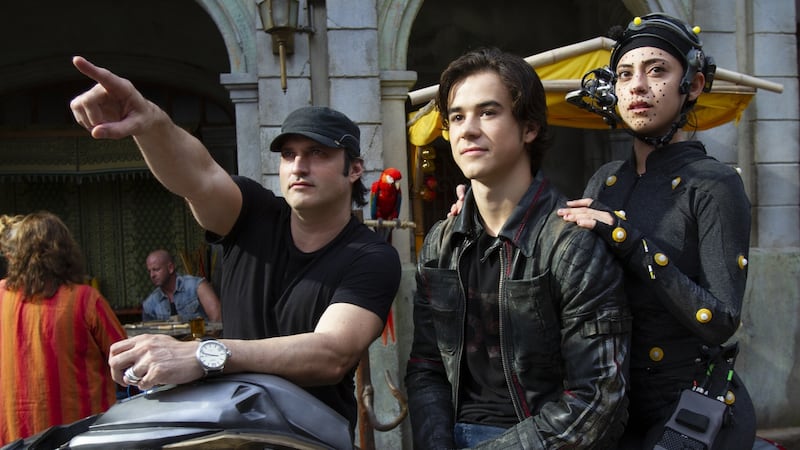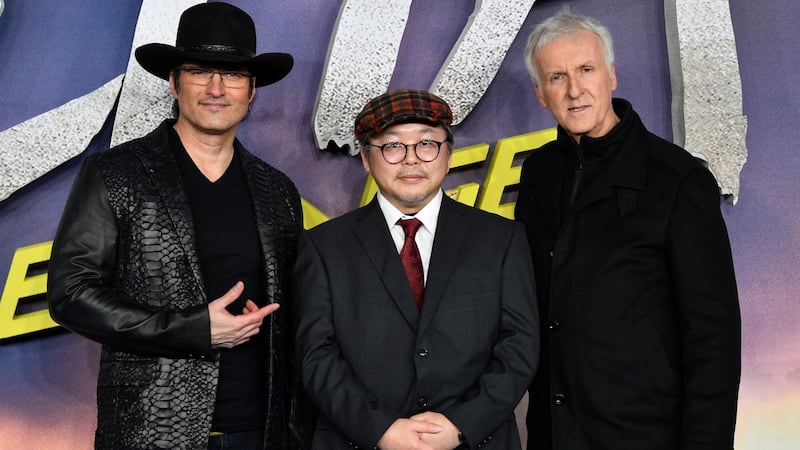The Texan auteur Robert Rodriguez exploded on to the international stage in the early 1990s with El Mariachi, an award-winning actioner that gunned its way into the Guinness Book of Records as the lowest-budgeted film to gross more than $1 million.
As recounted in Rodriguez's guerilla-filmmaking manual, Rebel without a Crew: Or How a 23-Year-Old Filmmaker with $7,000 Became a Hollywood Player, that $7,000 was cobbled together from a short-film prize and from money Rodriguez earned as a medical-test guinea pig. He still has two scars in his arm where a speed-healing drug was tried out.
“I remember standing up in front of the audience at Sundance saying: ‘You’re going to get a lot more entries next year when people find out that a movie made for $7,000 with no crew won. Everyone’s going to pick up a camera and start making a movie.’ And sure enough, the next year a lot of independent filmmakers did just that.”
Film-makers were like rock stars. Instead of thinking, I'm going to go practise on my guitar in my garage, they were picking up a camera. People wanted to be cool like Quentin
By the time El Mariachi premiered at Sundance in 1993, a year after Quentin Tarantino's Reservoir Dogs debuted at the festival, it already felt as if Rodriguez was emerging as part of an exciting new wave of independent American film-makers.
"It totally did feel like a movement," says Rodriguez, looking nothing like 25 years older than the outlaw auteur who turned up at Sundance in 1993. "When something like that happens, you think it happens all the time but it was actually unheard-of. So Quentin's film did well. And my film was doing well. And Clerks came out the next year. So it felt like a wave.
"When you look back in history you can see it has happened before with Francis Ford Coppola and Easy Rider and John Milius. But at that moment, film-makers were like rock stars. Instead of thinking, I'm going to go practise on my guitar in my garage, they were picking up a camera. It was really cool to be a director at that moment. People wanted to be cool like Quentin."

The writer, director, producer, visual-effects supervisor, camera operator, production designer, sound editor and composer behind the Spy Kids and Sin City films has retained that early outlaw aesthetic throughout his career. His many roles on every film set has kept costs down and, as he says only half-jokingly, made sure that "no one much is around to see when I screw up". In 2013 he founded the Latino American television network El Rey, which features Rebel without a Crew the TV series, in which 12 aspiring film-makers complete a feature film in two weeks for a budget of $7,000.
"I've been offered bigger-budget movies and stuff but I found my niche with El Mariachi," says Rodriguez. "I found the kind of film I wanted to make. I always wanted to make my films look bigger than they were. I had freedom. I didn't really want to go and work for someone else or a studio movie, as enticing as that might be.
“When they offer it to you, it’s still their movie. They’re going to tell you how to cast it; they’re going to tell you how to make it; they’re going to tell you how to end it. They spend a lot of money and they want their money back. I’d rather nobody spent a lot of money.
“If it’s a lower budget and a minimum payout, I can do anything I want. I never wanted to leave that behind. It was just too big of a trade-off. It sounded too much like work.” He laughs. “And I’ve never worked a day in my life.”
Rodriguez is the last person one would expect to team up with James Cameron. The pair have been friends for many years, but it's hard to see how Rodriguez's pulp sensibility could ever gel with the director behind the extravagantly budgeted Titanic, a film-maker who is currently spending more than $1 billion shooting back-to-back Avatar sequels. Rodriguez points to Cameron's original cheap-and-cheerful work for Roger Corman.
Jim Cameron would rather put something in a drawer and not do it at all than do it incorrectly with the wrong director
"Jim Cameron comes from the same place as me," he says. "He comes from genre. It's just that he has expanded out and into this whole other thing. We're friends for years. We've almost worked together twice before. He doesn't make typical Hollywood films either. Look how long Titanic spends on the characters before anyone even mentions an iceberg.
“We are different. My films are very targeted. I’m thinking about the gangster audience. I’m thinking about what little kids would like to see. I put jetpacks on kids. That’s just the way my imagination has always worked. I’m okay with dream logic and fantasy. Jim needs to know about the science of the jetpacks. So for this film, I had to think like I was making a James Cameron movie; I couldn’t make it like a Robert Rodriguez movie.”
This movie is Alita: Battle Angel, perhaps the longest-awaited anime adaptation in Hollywood history. Alita, or Gunnm to use its original title, was initially published in 1990 and was adapted as an anime in 1993. James Cameron had intended to follow up his short-lived TV series Dark Angel with a live-action version. Instead, he abandoned his unwieldy 186-page screenplay – not to mention 600 pages of notes – passing the hefty brief to Rodriguez.
“Jim would rather put something in a drawer and not do it at all than do it incorrectly with the wrong director,” says Rodriguez. “I saw his original drawings and they took my breath away. The main character had porcelain arms and huge manga eyes, and I thought, Wow, he’s going full manga with this. And he trusted me with the version that was in his head, and he said: if you fix the script for me, you can direct. So a month later I come back and say: here you go, free of charge. And he said: all right, it’s yours.”

A mix of computer-animated actors (including Rosa Salazar, who, in a motion-capture suit, plays the title role), and non-animated performers (Jennifer Connelly, Mahershala Ali, Christoph Waltz), Alita: Battle Angel was shot on practical sets at Rodriguez's studio lot in Austin, Texas.
“We did worry about how it would all fit together,” he says. “We kept the line in there that she wasn’t completely human. Because even a few years ago, we couldn’t have made her look like she does. The technology just about exists now so that she isn’t completely flat-looking. And when you talk to Rosa, she’s so full of life. I thought if that can come out, if that can come across on the screen, she’ll be as relatable as the human characters. Maybe more so. It always felt like a home movie. I wasn’t making a movie for Fox. I was making it for Jim. And Jim and I are buddies. So if we liked it, that’s what we did. I felt like I had my own Terminator with me to protect me. It was pretty much like working on an independent film.”
George Lucas has stayed in Marin County, outside of Los Angeles, for all these years. Because if you want to think outside the box, you have to live outside the box
With an estimated $200 million production budget, it’s easily the biggest price tag of Rodriguez’s career.
“Jim said if he had made it it would have cost twice as much,” the filmmaker says with a laugh. “So they’re getting a bargain. They’re getting it half-price.”
Between adding bells and whistles to Alita: Battle Angel, Rodriguez has been beavering away on various projects, including 100 Years, a film scripted by and starring John Malkovich, funded by Louis XIII Cognac, and not scheduled for release until 2115, a Machete sequel set in space, and Red 11, a horror inspired by his time as a medical-test subject and shot, as ever, back in Austin, Texas.
"Richard Linklater and I both live there and I have to say, by staying in your community and making your movies there, and using local workers, it creates a ripple effect that is ultimately huge," says Rodriguez. "They start their own businesses. The entire community ends up transformed. I remember George Lucas saying I was smart. He has stayed in Marin County, outside of LA, for all these years. Because if you want to think outside the box, you have to live outside the box.
“I wasn’t being smart. The reason I stayed in Austin was because I was too young and too lazy to know any better. But looking back, the reason I started doing digital before anybody, or working with green screen before other people, the reason I shot the first digital 3D movie, was not because I’m such a cutting-edge guy. I just don’t live in Hollywood so I don’t have people telling me what the right way is to do things. There was never anyone to whisper in my ear: hey, you’re doing it wrong.”
Alita: Battle Angel opens today


















